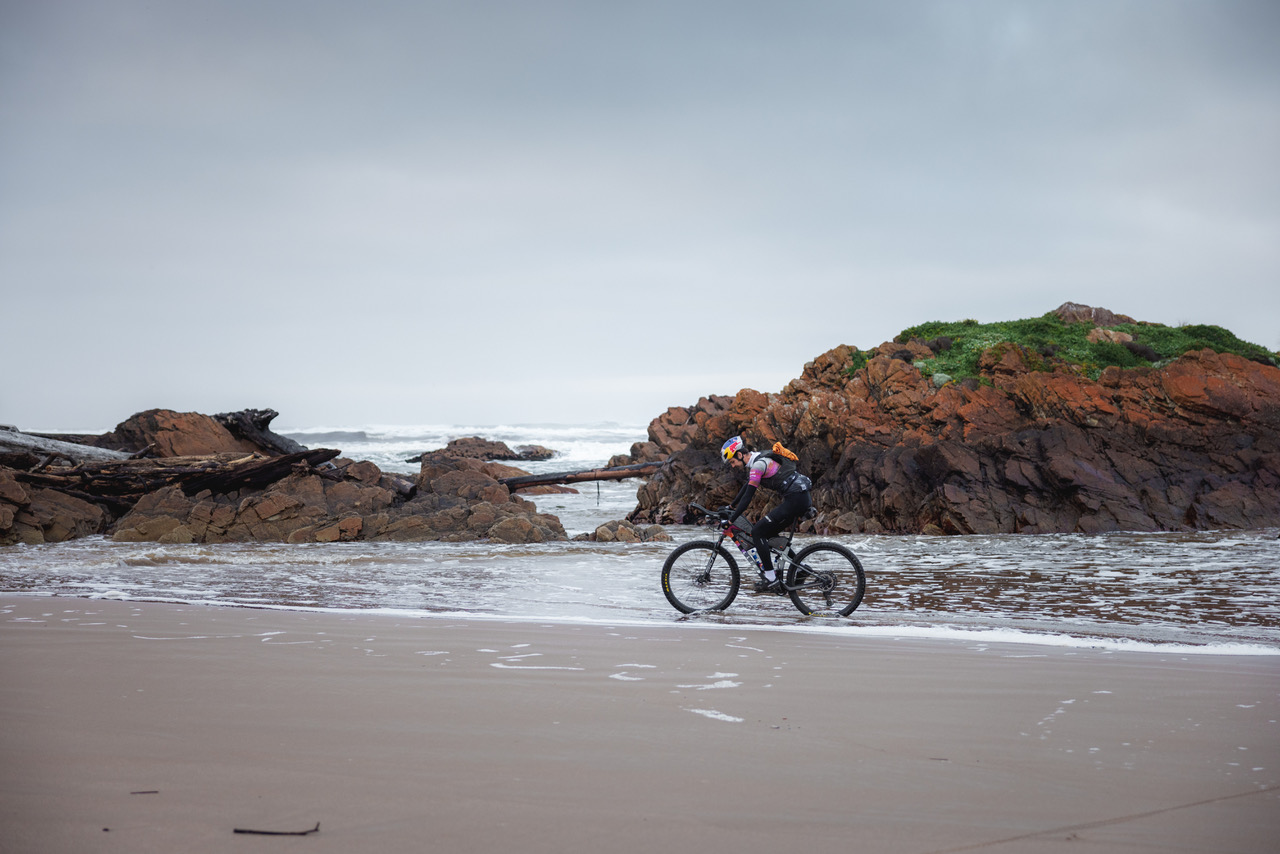By Jill Homer — The Iditarod Trail connects the Yukon River to the Norton Sound via an eighty-mile overland traverse known as the Kaltag Portage. The geography here resembles a crinkled piece of paper, with small mountains rippling across every horizon. Travelers follow the path of least resistance along the Kaltag River, where the trail wends in and out of steep embankments on a gradual rise to a pass. Beat told me the Kaltag Portage was one of his favorite segments of the Iditarod Trail — high tundra where everything is sparse, except silence.
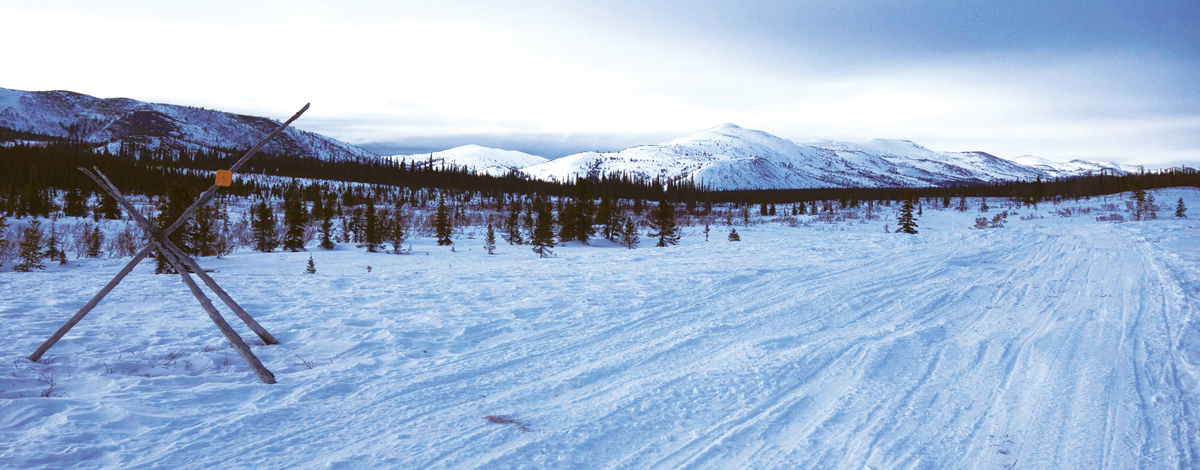
I rolled away from Kaltag at first light, when the sky was still a gray pall. I struggled to engage even my lowest gears as I pedaled through a suffocatingly thick forest. My breathing was disproportionately labored for this meager effort.
“It’s just a morning funk,” I assured myself, ignoring the similarities to the early stages of every other physical shutdown I’d experienced in the past year.
Despite the respiratory angst, I felt a thrilling buzz of anticipation. This electric sensation hearkened back to Friday night adventures as a teenager, riding shotgun along State Street and stretching my arm out the open window, as far as I could reach into the summer night. It was the feeling that anything and everything could happen, and not even the stars could predict what life-altering experiences my friends and I would forge before the neon-lit darkness faded to dawn.
My life had changed a fair amount since my greatest adventures encompassed dragging the main strip of downtown Salt Lake City in a Chevy Cavalier, but this adolescent zeal returned each time I ventured beyond the edge of my known universe. I believe outdoor adventures are a fountain of youth for many reasons, but the most prevalent is their preservation of childlike joy.
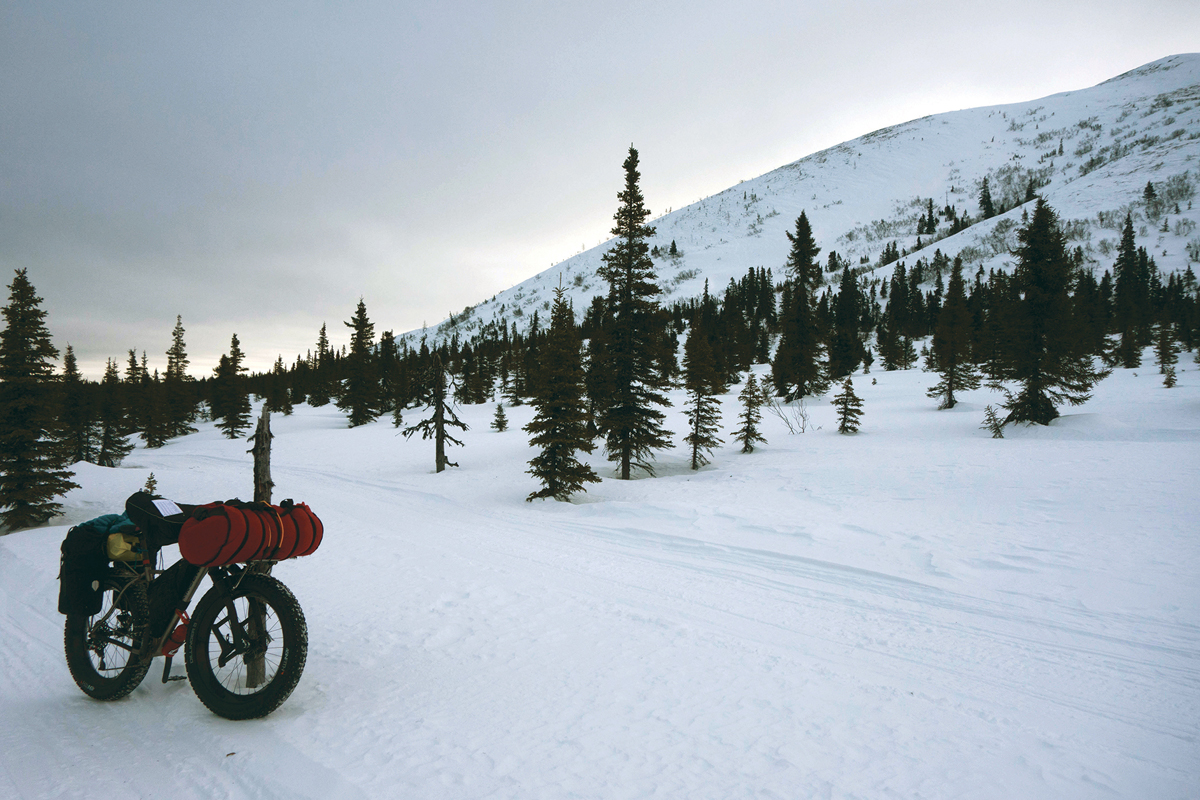
I’d ventured far beyond my pessimistic expectations, and every bend in the trail was a new triumph. The Kaltag River was laced with open leads that burbled menacingly, but every crossing was spanned by an ice bridge. After pedaling across four of these bridges without incident, I felt invincible. The trail climbed to the cusp of tree line, and the thick forest gave way to spindly black spruce, which gave way to bare, rolling hills.
Each crest brought a steep descent, which I hadn’t encountered in days. Now that my numb right hand was almost rigid, I no longer had the dexterity to steer or the strength to press the rear brake lever. As a result, my descending skills were severely compromised. I clasped the front brake and held on for my life as the rear wheel fishtailed dramatically, stirring up clouds of snow. I managed three lucky drops, but on the fourth hill, I lost control at twenty miles per hour. The front wheel plunged into a snow bank, flipping my body over the handlebars and tossing me into a hollow more than six feet off the trail. I was buried face-down in a drift, thrashing violently amid an exhilarating rush of adrenaline. After freeing myself and crawling back to the trail, I shook like a wet dog. My coat, hat, and boots were packed with snow, and the explosion of powder evoked a maniacal laugh. Nothing could touch me! I was unstoppable!
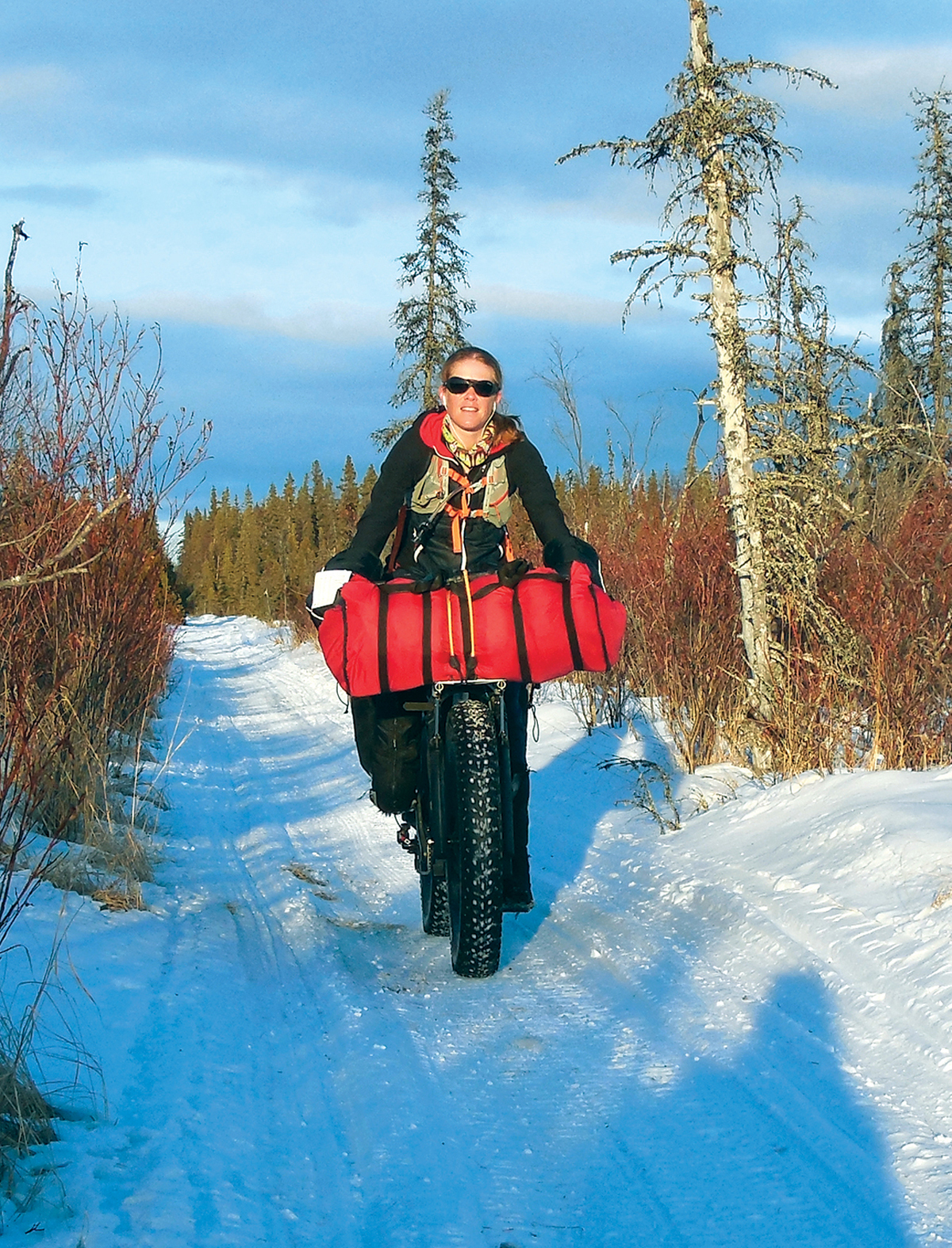
At noon I ate the last of the protein snacks I’d scavenged in Galena. I managed to cover twenty-two mostly uphill miles in four and a half hours, so traveling sixty more to the village of Unalakleet seemed like a feasible goal for the day. It felt unreal — the possibility that later that evening I’d return to the village where I started my ill-fated bike tour a year earlier, and left vowing never to return. Of course, I’d have to put in a hard effort if I wanted to reach Peace on Earth Pizza at a reasonable hour. The carrot of a hot pizza — and even more enticing, fresh salad and fruit juice — pulled me forward. I concentrated on rhythmic breathing and visualized a cartoon-like depiction of proteins replenishing my depleted muscles. This is another benefit of a childlike mind — the uninhibited hope that imagining something will make it true.
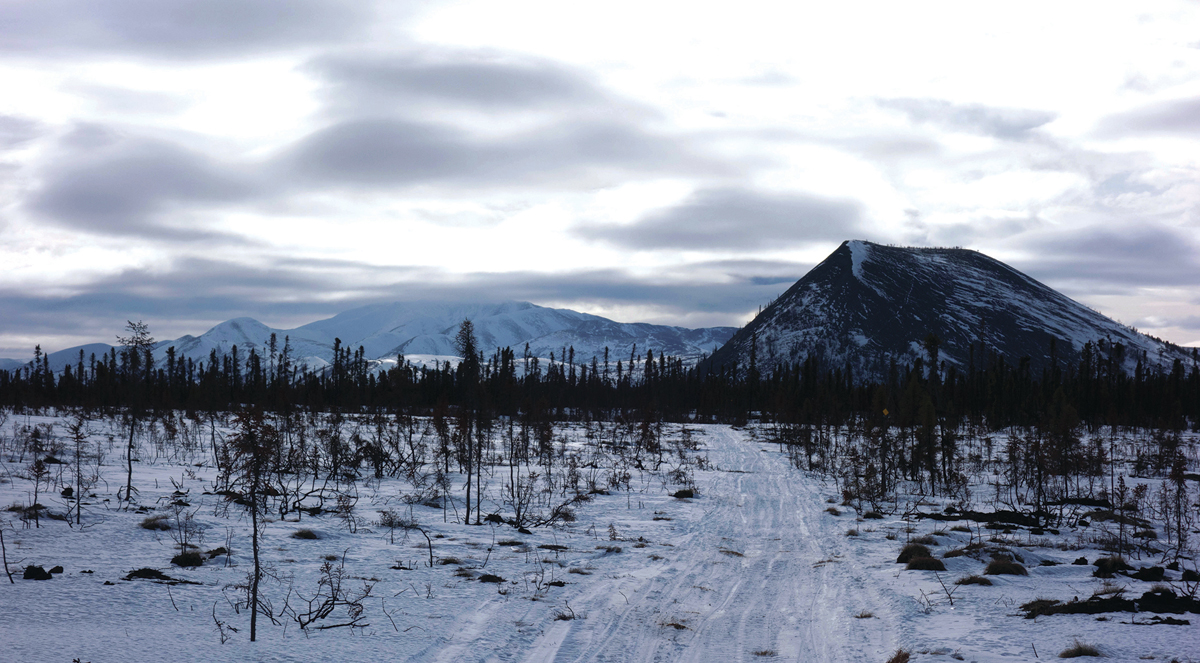
In the golden light of mid-afternoon, I descended through a charred forest toward a pyramid-shaped peak known as Old Woman Mountain. Iditarod legend tells the story of an old woman who ascended this mountain against the wishes of village elders, who believed such an arduous task was too dangerous for a woman. Because of her defiance, she was swept away in an avalanche, never to be found. Now her spirit haunts this desolate valley, cursing travelers so they too can never leave.
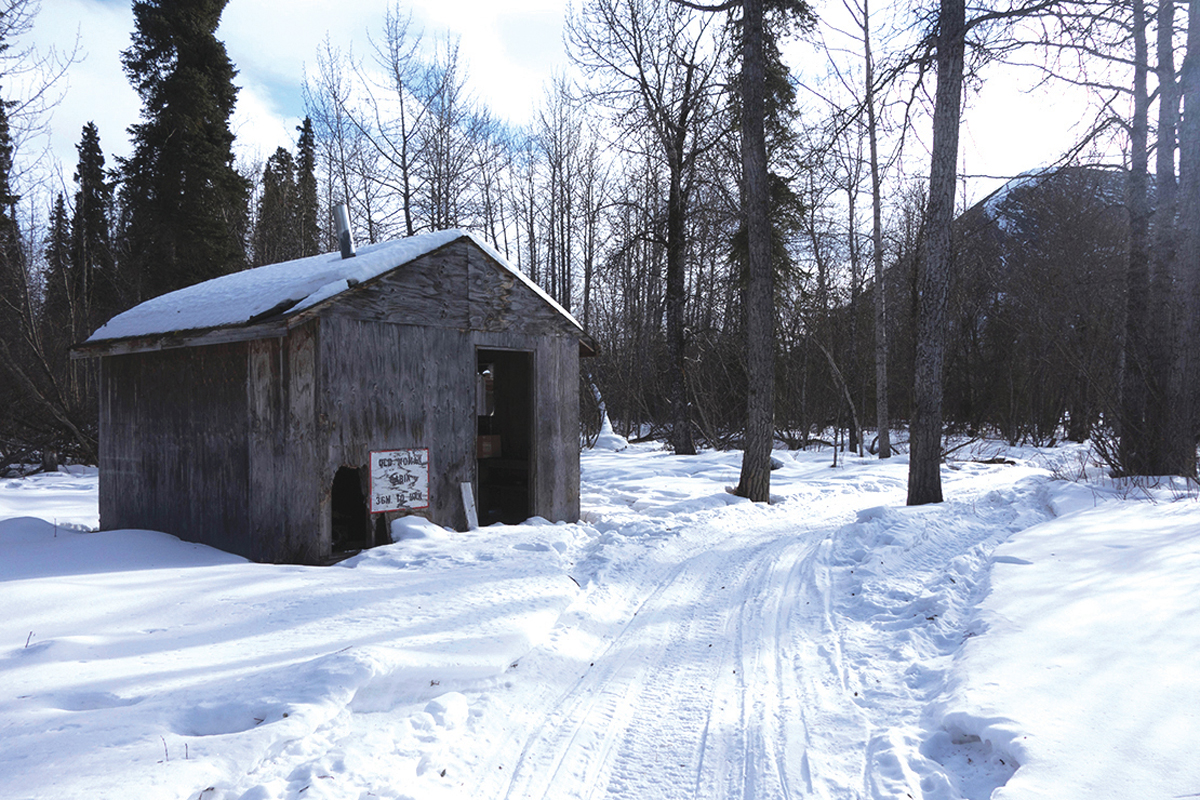
Iditarod mushers tell of sudden bouts of crushing fatigue and inexplicable urges to slow down or rest when passing beneath the Old Woman’s mountain. Legend holds that the ghost also has the power to generate terrible storms. A shelter cabin was built here to protect travelers from weather that reportedly is among the worst in Alaska. According to musher superstition, if an offering is left at the cabin for the Old Woman, she will spare the traveler. Otherwise, she will curse them with bad luck until Nome. Women are said to be especially susceptible to her curse, so I came prepared with an extra Snickers bar to sacrifice.
After several decades, the Old Woman cabin had fallen into disrepair, to the point where it could provide neither shelter nor respite for any traveler. The roof was collapsing, plywood walls were punched full of holes, and the door was missing. The interior was filled with garbage — empty food containers, rusted gasoline canisters, and snowmobile parts. As I approached the cabin with my chocolate offering in my hand, I was loathe to add to the garbage pile.
“Let her haunt me,” I thought, placing the candy bar back in my top tube bag. “She can’t slow me down.”
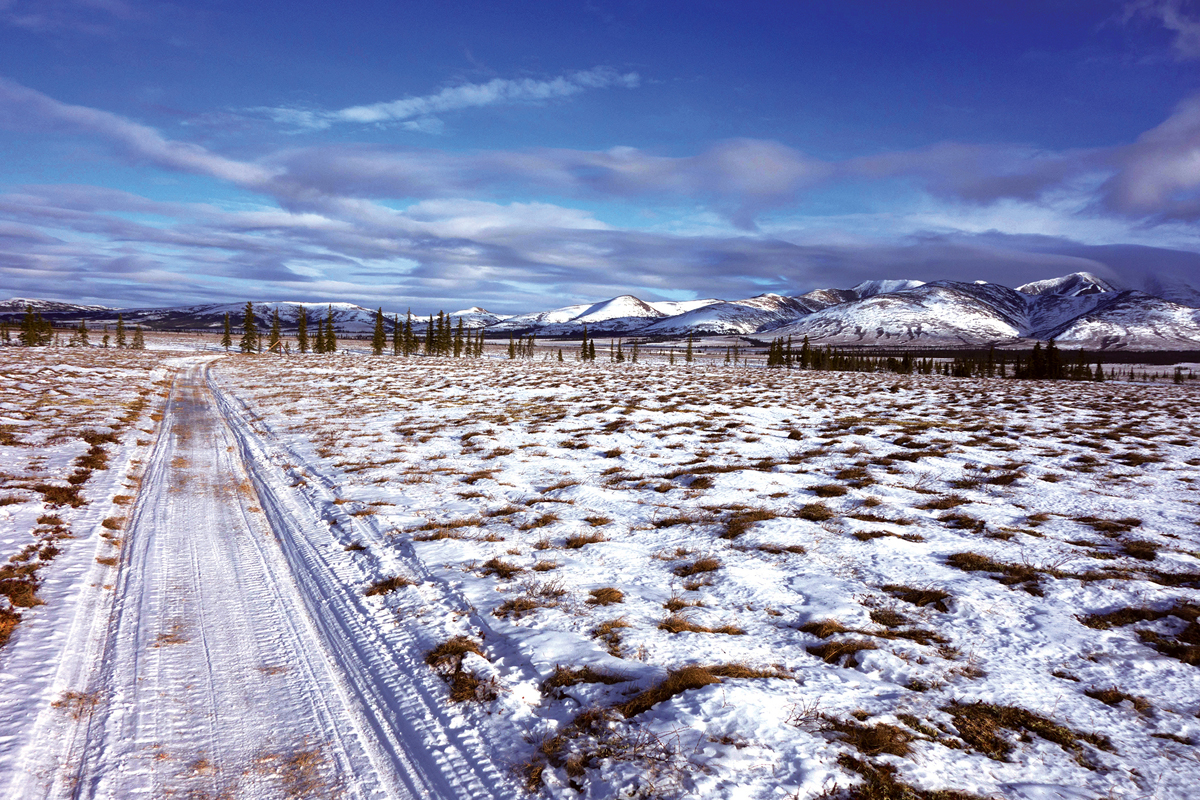
A few miles down the trail was a new Bureau of Land Management shelter cabin that also bore the Old Woman’s name. Although superstition wouldn’t allow me to believe that an ancient ghost would just pick up and move to a nicer location, I pondered leaving my Snickers bar there to ensure a smooth trip into Unalakleet. Two men on snowmobiles were just pulling up when I arrived. One introduced himself as Kevin Keeler, a BLM employee whose Facebook page I followed for the latest trail updates. The other was a Native man from Unalakleet who was joining Kevin for a few days of work on the Iditarod Trail. As I paused to talk with them, I mindlessly gnawed on the frozen candy bar I’d intended to leave inside the cabin. This was only my second encounter with non-cycling humans on the trail — my first being the state troopers on the Yukon — and I enjoyed conversing with them. Kevin was particularly interested in my raggedy clothing system. The layers on my legs looked like a homeless person had cobbled together scraps of fabric from a dumpster.
“These aren’t pants, they’re actually primaloft shorts and homemade overboots,” I explained. “I use these detachable knee warmers because my knees are always cold, but I open the zips on my shorts because my thighs are always warm. I have to wear a hood over my balaclava to keep my ears and face warm in the wind, but open up my jacket to vent the heat from my core. Sometimes my butt is cold but my back is scalding. I’m always running both hot and cold somewhere.”
“That makes sense,” said Kevin, who was thickly bundled up in a one-piece snowmobile suit and full-face helmet. Although driving a snowmobile is far from a sedentary activity, snowmobilers aren’t as prone to sweating and can afford to wear heavy insulation. I envied them for this. Human technology allows us to wander through the harshest climates on Earth, but biologically we’re built for life on the savanna. Our bodies’ ultra-sensitive cooling system remains active even when our survival depends on staying warm and dry. While engaged in strenuous exercise, I needed to somehow vent moisture and retain heat at the same time — an impossible task because it defies the laws of physics. Since there’s no way to strike a balance, I was forced to reach compromises. Those compromises took me from overheated to shivering in the ten minutes I spent resting at the new Old Woman cabin.
“Sorry to run, but I’m getting really cold just standing here,” I said. “I should go.”
Kevin told me Unalakleet was thirty-seven miles away. I looked at my watch — 4:30 p.m.
“I wanted to hit the pizza place by nine,” I announced. “I’m going to have to book it.”
I bid them goodbye and continued pedaling down the winding trail along Old Woman Creek, with the menacing north face of Old Woman Mountain directly overhead.
“Those avalanche gullies look like they’re right on top of me,” I thought. Steady wind emitted a high-pitched hum — eerily similar to a siren. I regretted eating the Snickers bar that should have remained in the derelict cabin. But the infusion of sugar and the conversation with real, living people gave me a needed boost. Spinning the pedals faster, I imagined a specter in a tattered caribou-skin robe, floating over my head. My childlike state of mind gave weight to this fantasy, until I was looking over my shoulder every time a gust of wind screeched through the trees.
“Old Woman, go away, go away, go away,” I chanted.
The screeching intensified as the valley opened up and the forest again diminished. With no trees to block the wind, whistling gusts slammed into my back and pushed me down the trail. At thirteen or fourteen miles per hour, the landscape suddenly went silent. It’s always a little unsettling to hit wind speeds on a bicycle — sounds are muted and the air becomes calm. It feels as though time has stopped. You can see that you’re still moving forward, but inside this invisible bubble, everything is eerily still. It’s an otherworldly state that can mean only one thing: an incredible tailwind. As it turned out, the Old Woman was trying to push me away.
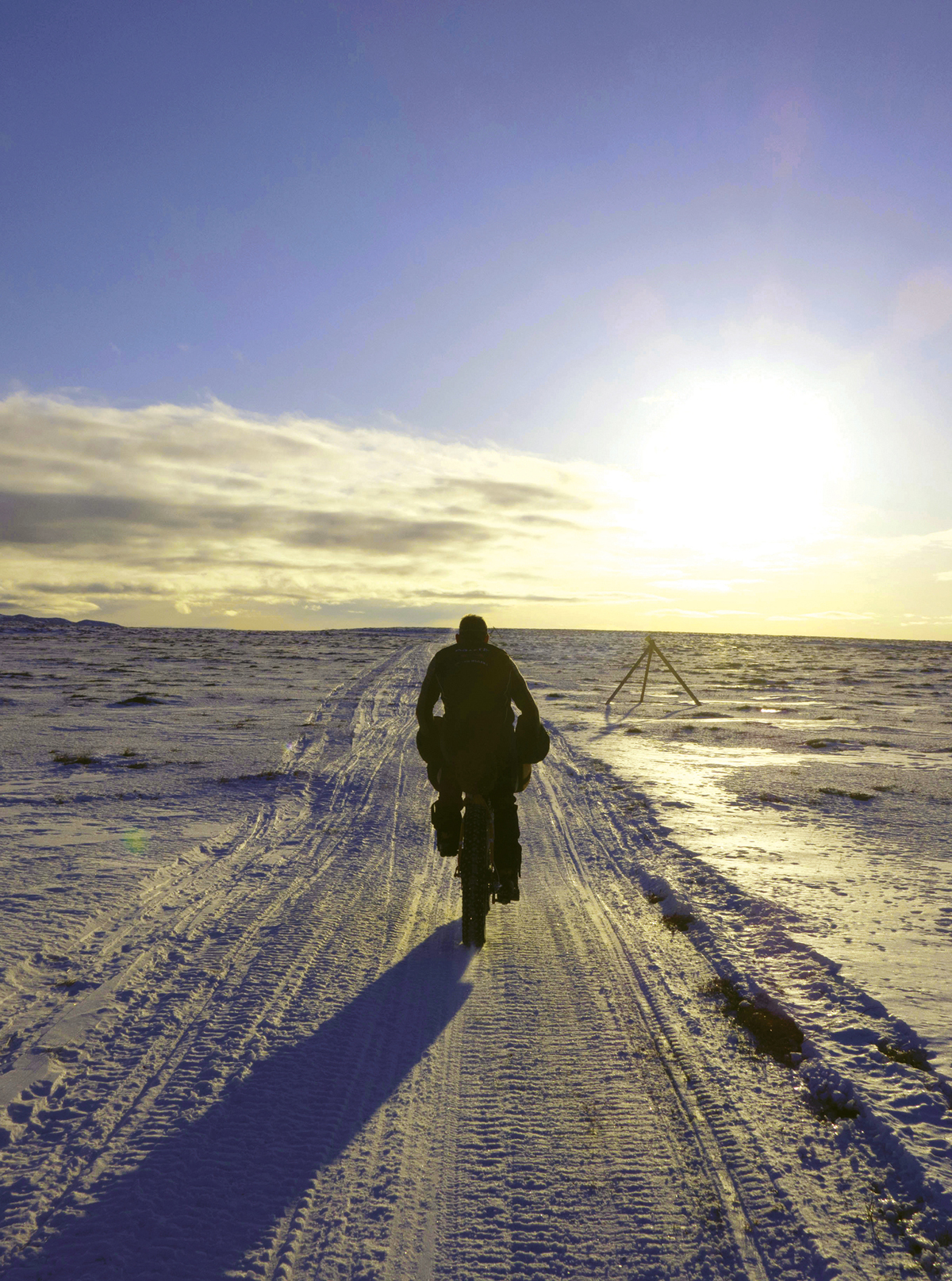
I pedaled as hard as I was physically able, straining to remain inside this wind-speed bubble. As the valley opened up, snowpack diminished until the ground was a patchwork of brown tussocks and sugary clumps of snow. Wooden tripods marked the trail, which was barely discernible from the uneven landscape, yet felt smooth underneath my tires. Rounded mountains towered over the southern horizon, cast in gold and silver light in the late afternoon. To the north was a thin strip of spruce trees snaking down the valley — the corridor of the Unalakleet River. Exhilaration surged through my veins, and I pedaled until my legs and lungs were searing with hot blood and cold air. I didn’t fret because I truly was unstoppable. The Old Woman was on my side.
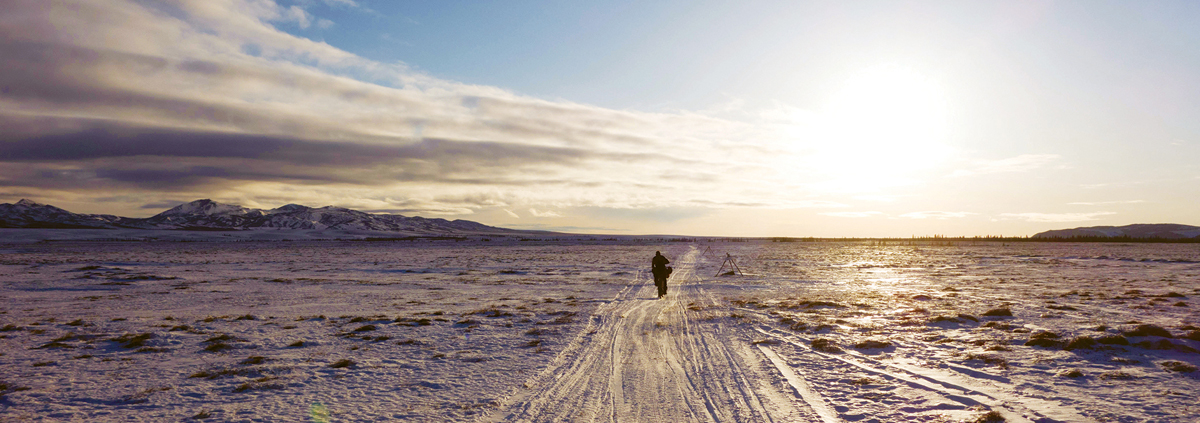
Progress came to a screeching halt when I dropped onto the river and approached a sheer rise on the other side. The river bank was only five feet high, but so steep that it might as well have been a wall. My numb right hand no longer contributed to pushing efforts, and all seventy-something pounds of the bike pressed against my chest. As I struggled to shove it forward, I heard a loud “Wooooo” from behind.
“I wondered when you’d catch up to me,” I said without glancing backward. My poorly anchored left foot inched down as I spoke. “You picked a bad time. This is going to take all night.”
Without a word Mike pressed both hands against my butt and shoved. I was so startled that I lunged toward the lip of the river bank. I might have taken offense, but it was clearly the most logical thing for him to do in that moment.
“Uh, thanks,” I said. “These steep banks always get me. If I ever do this race again, I’m going to make sure I get a whole lot stronger.” This was a lie on multiple levels.
“No problem,” Mike said. “How far do you think it is until Unalakleet?”
“Probably about twenty miles.”
“So two hours?”
“Maybe for you,” I said. “The tailwind is dying, and so am I. The sun starts to set and suddenly everything shuts down.”
“I love riding in the evening,” Mike said. “I finally feel awake.”
“I don’t know about you, but pedaling all day makes me kind of tired,” I said. “Did you make it to Kaltag last night?”
“Yeah. I got in around midnight. I followed bike tracks to that apartment and knocked on the door, but no one answered. I looked through all the windows, but all I saw was this big dude in his underwear, and decided to get out of there. Luckily Doug got up and let me in the school.”
“Oh, I’m sorry,” I said. “I did not hear you at all.”
Mike shrugged. “It all worked out. I checked out the place in the morning. Looked nice in there.”
I blushed. “It was pretty decked out. Too bad you didn’t get there earlier. I went to sleep around ten thirty.”
We remounted the bikes and started pedaling. “You go ahead,” I said. “I started before eight and I’m guessing you left around noon … so yeah, tell the pizza guys I’ll be there in an hour.”
He passed with a devilish grin on his face. “Race you?”
Mike was strong and highly food-motivated. I doubted I could hold his wheel for a minute, but sprinted toward him anyway. Beside the trail, wind had carved intricate designs in the snow that reminded me of a plaster mosaic. The sun lingered just over the horizon, casting a metallic glow across the valley. A long shadow stretched from Mike’s silhouette, until it looked like I was chasing a phantom. The Old Woman’s wind had become a gentle breeze, caressing a patch of skin on the back of my neck. Mike and I raced as though Unalakleet were the end of the trail. We strained as though pizza was the ultimate reward. And we smiled as though the coast — the brutally exposed sea ice, the North Wind, and all of the hardest parts of the Iditarod Trail — was behind us, not ahead. Fatigue was consumed by fire, until everything about this evening was intoxicatingly perfect. I decided this was my best-ever day on a bike. I say that frequently, but this was truly it.
Mike still beat me to Unalakleet by more than twenty minutes. I lost ground after the trail meandered onto purple river ice, where I pedaled delicately and watched a salmon-colored sunset fill the entire sky. Three miles from Unalakleet, I descended a final hill and saw a twinkling strip of lights strung along the black, open ocean. “The Coast,” I breathed out. I’d returned.
With nearly seven hundred residents, Unalakleet is not only large enough for a real airport, but also several restaurants. Peace on Earth Pizza had taken to supporting the Iditarod races by offering floor space and pizzas any time of the day or night. Fresh ingredients are expensive out here. Large pizzas cost forty dollars for the works, but are worth every penny.
Thanks to Mike’s and my impromptu race, we both arrived during proper business hours and put in an order for a large vegetarian, two full-plate salads, and Odwalla smoothies. I took the rare Wi-Fi opportunity to pull out my phone and check e-mails, making it through two before I forgot how to read and mindlessly clicked on bookmarks. I announced to Mike that I was checking the weather.
“Friday in Unalakleet,” I read out loud. “Highs around five above. Northwest wind twenty to thirty miles per hour. Shaktoolik. Highs zero to five above. North wind thirty miles per hour.”
I looked up and let my jaw quiver for a few seconds.
“So that’s good?” Mike interjected.
“That’s bad!” I yelled. “I saw a better forecast in Unalakleet last year — remember I told you about the short trip where I almost got mowed off the sea ice? If they say it’s blowing thirty in town, it’s gusting to fifty on the ice. And a northwest wind is going to be right in our face all through the Blueberry Hills.”
“After the last few days, I’m getting pretty used to headwind,” Mike said.
“Those were like ten miles an hour, gentle breezes,” I said. “This is like … we’re going to die.”
“Ah, it will be fine,” Mike said. “Don’t be such a pessimist.”
“It’s best to be a pessimist,” I said. “I’m either right, or I’m pleasantly surprised.”
We polished off our pizza while continuing to surf the Internet on our phones. I don’t recall reading anything or enjoying a single bite of the formerly anticipated pizza and salad. All I remember is the leaden taste of doom.
Jill Homer is a freelance editor and writer in Boulder, Colorado. She enjoys exploring the world around her on two feet or wheels, and writes about her adventures at jilloutside.com.
This essay is part of “Into the North Wind,” which is her memoir about setting the women’s cycling record on the Iditarod Trail in 2016. The book is available on Amazon, and the audiobook was just released on Audible.






